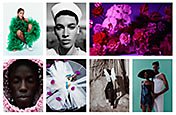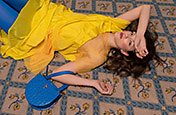Discover the art of colour

Whether you’re looking to take your photography to the next level or kickstarting your photography journey, using colour is a core skill for any photographer.
Colour photography is a genre of photography and incorporates a wide range of styles, but ultimately is photography that uses media capable of capturing and reproducing colours, as opposed to black-and-white or grey-monochrome.
“Working with colour in photography is a vibrant and exciting approach to photography and a way to express your creative vision and explore emotions and through the lens,” says product and still life photographer Tori Annesley.
Whether you're capturing in the moment or editing in post-production, colour photography is all about controlling and adjusting colours to create a mood or feeling.
How to use colour theory to your advantage
Colour theory is a group of guidelines that are often used in art to communicate with colour through visual mediums. It's also a great place to start when using colour in photography. Start by using primary and secondary colours to create colour harmony by choosing a monochrome, complementary or analogous colour palette for your image.
- Different colours elicit different emotions when viewed. You’ve probably heard that blue can be viewed as sad or cooling, yellow as happy and red as passionate, powerful or heated. Think about what emotion you’re trying to convey to your audience when choosing your colour palette.
- Colour palettes are a great way to visually see how different colours go together. Adobe Color is a powerful tool that allows you to view pre-made colour palettes or create your own using the colour wheel. Another way to find your perfect colour palette is to import an image into Adobe Colour and extract colour palettes from it using the Extract Theme feature.
Types of colour photography
There are some specific examples of colour photography that approach colour in a minimal way, such as colour contrast photography, selective colour photography and colour splash photography.
Colour Contrast photography is a method of using two contrasting colours on the colour wheel. For example this image uses purple and yellow, a primary and secondary colour that are opposites on the colour wheel, to let the yellow bottles pop off the background and become the hero of the image.

Selective Colour Photography/Colour Splash Photography
Selective colour photography or colour splash is a style of photography that isolates one colour in an image and desaturates all other colours in the photo. This technique is popular among street photographers to highlight subjects in busy images such as cityscapes and can be particularly effective in low contrast images to guide the viewers eye to the focal point of the image.
Getting started with colour photography
Colour is a vibrant and exciting way to approach photography as a medium, but co-ordinating the colours in your photography can sometimes seem daunting and can overwhelm the subject in your images when used incorrectly. From planning your images to adjusting your camera settings, there are a few things to consider when getting started with colour photography that will set you up for success.
Find your subject
If you want to capture colour, then it’s time to find a colourful subject. Have you got a colourful vase in green and blue hues you can’t stop looking at? Or perhaps the hot dog you ordered for lunch is calling to you with its red and yellow condiments. Whatever you choose, establish what colours you’re capturing in your subject and then you can start figuring out your supporting elements and complimentary colours. The trick is to use colour strategically - add a pop of colour so that it stands out in its environment, instead of using so much colour that it’s hard to know what to focus on.

When setting up your subject and camera, it is best to capture your images in RAW mode which will give you more flexibility when editing, without losing the original data. This gives you room to play around with colour adjustments and colour correction in post-production software like Lightroom and Photoshop and get creative with your editing process.
Choose your light
When shooting colourful objects, the type of light you use matters. A direct light source like sunlight will produce harsh shadows but also make the colours in your image look vibrant and saturated, whereas a softer light source like a window or softbox will create more muted tones. Choose your light source based on the mood you’re trying to create within your image and how you want your colours to look.
Adjusting light settings in camera
“When it comes to camera settings and exposing for colour photography, I often find myself using a similar configuration from one shot to the next,” says Tori.
Use a higher aperture (f14 or f16) to create a wider depth of field to capture all the detail of your colourful subjects. This often means that if your lighting or quality of light changes , it will adjust your ISO and shutter speed to suit.
“As I usually work with stationary subjects, I can adjust my shutter speed to a lower setting if I require more light - as long as I use a tripod to minimise and camera shake and motion blur,”
Understanding Hue, Saturation and Luminance
Colour grading is your friend when it comes to post processing your colourful images. Using Lightroom to control your colour saturation, adjust your hues and isolate colours is an essential part of the process of using colour in your photography.
To use the HSL panel in Lightroom, click the colour drop down menu in the edit panel and adjust the sliders on your chosen colour. “This is a feature that I use often to adjust particular objects that might benefit from a slight colour change or if I think a particular colour needs to appear brighter or more saturated overall in the image,” says Tori
The basics panel in Lightroom can often get overlooked, however it plays a key role in the editing process of colour focused images. Bumping up the highlights and shadows creates a beautiful luminance within colourful images. Dehaze also brings forward a level of subtle saturation to eliminate that RAW image look and elevate the image further.
“Another tool I use often is the Colour Grading panel. This tool allows you to add colour into your images through the shadows, midtones and highlights,” says Tori. It is a great tool to use to play around with fun colour combinations specifically in the post-production process. When the panel is open, move the centre circle of each wheel to your desired colour and adjust the blending and balance of the three wheels to suit your images’ overall look.
The creative opportunities are endless when using colour as a tool in photography. By incorporating these tips and tricks you’ll be able to master the art of capturing colour accurately and using it to convey emotion which will take your images to the next level.
Contributors:
You might also be interested in…
Creating great portrait photography.
Take a step closer to perfect portraits with tips and advice from professional photographers.
An introduction to portrait lighting.
Learn the basics of portrait lighting to bring your subject’s story to life.
Tips for upskilling creative fashion photography skills
Learn how to plan and execute the perfect creative fashion photograph that showcases your vision and style.
Tips for choosing the best lens for fashion photography
Learn how to choose the ideal lenses and get tips for capturing stunning fashion photos.



